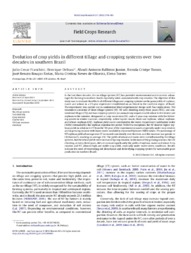Evolution of crop yields in different tillage and cropping systems over two decades in southern Brazil.
Evolution of crop yields in different tillage and cropping systems over two decades in southern Brazil.
Author(s): FRANCHINI, J. C.; DEBIASI, H.; BALBINOT JUNIOR, A. A.; TONON, B. C.; FARIAS, J. R. B.; OLIVEIRA, M. C. N. de; TORRES, E.
Summary: In the last three decades, the no-tillage system (NT) has provided environmental and economic advantages for farming in southern Brazil, especially when associated with crop rotation. The objective of this study was to evaluate the effects of different tillage and cropping systems on the grain yields of soybean, maize and wheat, in a 23-year experiment established on an Oxisol in the southern region of Brazil. The experiment was carried out in randomized block experimental design with four replications. The treatments consisted of three tillage systems [NT, NT with chiseling every three years (NTC), and conventional tillage (CT)] and two cropping systems [an annual crop sequence with wheat in the winter and soybean in the summer, designated as crop succession (CS), and a 4-year crop rotation with the following species in winter-summer, respectively: white lupine-maize; black oat-soybean; wheat-soybean; and wheat-soybean (CR)]. Soybean yields were correlated to the water requirement satisfaction index (WRSI) estimated for the soybean reproductive period. With few exceptions, the NT showed higher soybean yields in relation to CT from the 7th year of the experiment onwards, especially under crop rotation and in growing seasons with lower water availability expressed by lower WRSI values. The percentage of NT soybean yield advantage over CT increased consistently over the time, and this increase was greater in CR than in CS, reaching on average 23%. The yields of wheat and maize were not influenced by the tillage systems, but the wheat yields were increased by crop rotation. In the most of the growing seasons, the soil chiseling, at every three years, did not increase significantly the yields of soybean, maize and wheat. Crop rotation and NT, allowed high and stable crop yields, especially under water-stress conditions. Results indicate the need of minimizing soil disturbance and diversifying cropping system for sustainable grain production in southern Brazil.
Publication year: 2012
Types of publication: Journal article
Unit: Embrapa Soybean
Keywords: No-tillage system
Observation
Some of Embrapa's publications are published as ePub files. To read them, use or download one of the following free software options to your computer or mobile device. Android: Google Play Books; IOS: iBooks; Windows and Linux: Calibre.
Access other publications
Access the Agricultural Research Database (BDPA) to consult Embrapa's full library collection and records.
Visit Embrapa Bookstore to purchase books and other publications sold by Embrapa.

